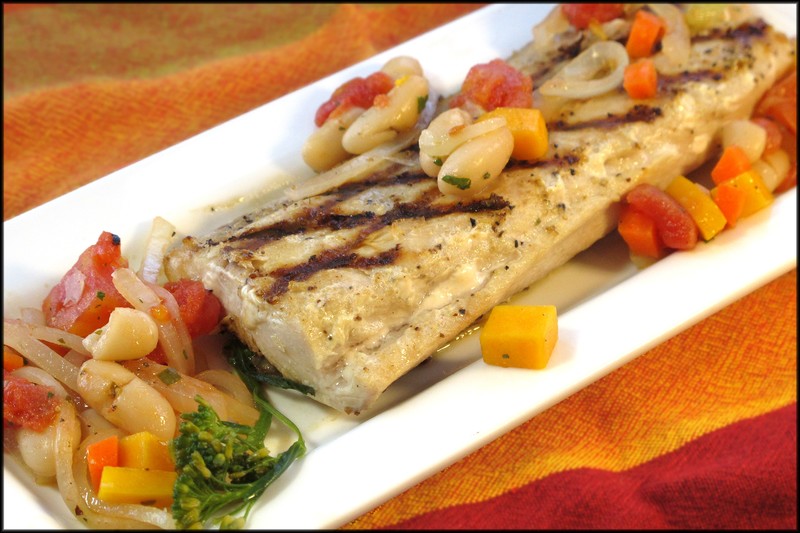We all have our favorite places to buy fish in this area (not counting the great local restaurants). Lewes Fish House and Big Fish Market are quite dependable in their quality and variety, but not always convenient to get to on grocery-shopping days. I’ve had mixed results with the fish counters in area supermarkets, where the flaccid filets typically seem dry and tired, nearly always labeled “previously frozen.”
I rarely purchase frozen fish (especially not in breaded fish stick form) because the few times I took the chance I was reminded why I shouldn’t. If the two-pound bag of shrimp is on sale, it’s likely because the stock was taking up too much space in the grocer’s freezer. It’s not that frozen fish is necessarily bad, but you may be getting more than fish.
If you read the ingredients on most packages, you might find a surprising addition, as in the most typical label which lists: Shrimp, Salt, Sodium Tripolyphosphate (to retain moisture). What may be disturbing is why this compound, which is considered by the FDA to be “generally regarded as safe,”is added here.
Sodium Tripolyphosphate or STPP is a chemical that is widely used across a number of industries. You will find it in paints, detergents and soaps. Almost all cleansers - gels, powders and liquids - contain STPP to help prevent dirt from sticking to the surface being cleaned and to soften hard water for better foaming performance of the various cleaning agents.
Why is it used as a preservative? Because STPP helps foods retain moisture on the journey from source to package to transport to market to sale to the table. Seafood isn’t the only place in the food chain you might find STPP; it’s also used to preserve red meats, poultry, milk and fruit juices. Not only does the chemical improve the appearance, it also retains moisture, affecting the weight of the product.
An alternative to this “wet” processing is to ask for fish that has been “dry” processed, which simply means nothing has been added to the food. I reacted with some surprise a few weeks ago when I found a brand of frozen fish that was treated in this preferable fashion. The package was from a company called Open Nature, and the label read: “Real food from natural ingredients wild caught mahi mahi fillets.”
I forgave them for misspelling the word filet when I looked at the ingredient list and saw only “Contents: mahi mahi (coryphaena hippurus).” This parenthetical information is the latin name for the common dolphinfish, which is the actual species now known as mahi mahi. Some marketing genius came up with the practice of using the fish’s Hawaiian name so people wouldn’t think they were dining on Flipper’s cousins.
I believe I may not be the only person who intensely dislikes mahi mahi filets that are too thin or with too much dark flesh and very little white flesh. When we opened this already surprising package, we found two individually wrapped pieces of fish, about six ounces each and with not one fleck of red flesh nor shred of skin to be seen.
To cook them, we simply brushed them with olive oil and placed them in a grill pan in their frozen state, as advised in the directions. In less than 15 minutes, they were cooked through, flaky, tender and delicious. The next time we tried them, we paired the filets with a variation of a bruschetta topping featured recently in the Washington Post. Their version of grilled bread, pureed almond sauce and cannellini beans with butternut squash was far more complicated than necessary, although it may have been tasty as described.
The recipe below is the pared-down version of the mixture of beans and squash seen in the photo with grilled mahi mahi filets.
The following day, we added some chicken broth and turned the sauce into a filling soup for lunch. For another bold pairing with mahi mahi, coat the filets with a spicy blood-orange rub before grilling. If all you have is fish without any STPP, the flavor and texture will be delightful.
Pan-Grilled Mahi Mahi
2 mahi mahi filets, about 6 oz each
olive oil
salt & pepper, to taste
Lightly brush both sides of the filets with olive oil. Sprinkle with salt and pepper. Heat a nonstick grill pan and cook fish, turning once, until flaky. Note: if using unthawed, frozen fish plan on 6 to 8 minutes per side; fresh fish will need only 3 or 4 minutes per side.
Cannellini Bean Saute
1 T olive oil
1/2 C sliced onion
1/2 C chopped red bell pepper
2/3 C cubed butternut squash
1 carrot, diced
1 celery stalk, diced
1/2 t thyme
1/4 t oregano
1 or 2 sage leaves
1/2 C vegetable broth
1 15-oz can cannellini beans, drained
salt & pepper, to taste
Heat the olive oil in a deep skillet over medium low. Add onion, bell pepper, squash, carrot and celery; sauté, stirring often, until softened. Sprinkle with thyme,oregano and sage; pour in broth, scraping up any browned bits from the bottom of the pan.
Stir in beans and simmer until heated through, about 5 minutes. Season to taste with salt and pepper. Serve as a sauce for fish, chicken or pork.
Spicy Blood Orange Rub
1 t salt
1 t pepper
1 t snipped chives
1/2 t onion powder
1/2 t paprika
1/4 t cayenne or to taste
juice of 1 blood orange
1 t olive oil
Combine spices in a small bowl. Add blood orange juice and olive oil, stirring to make a paste. Spread on mahi filets, pork tenderloin or chicken breasts before grilling.
Send comments, questions or recipe ideas to capeflavors@comcast.net.
























































